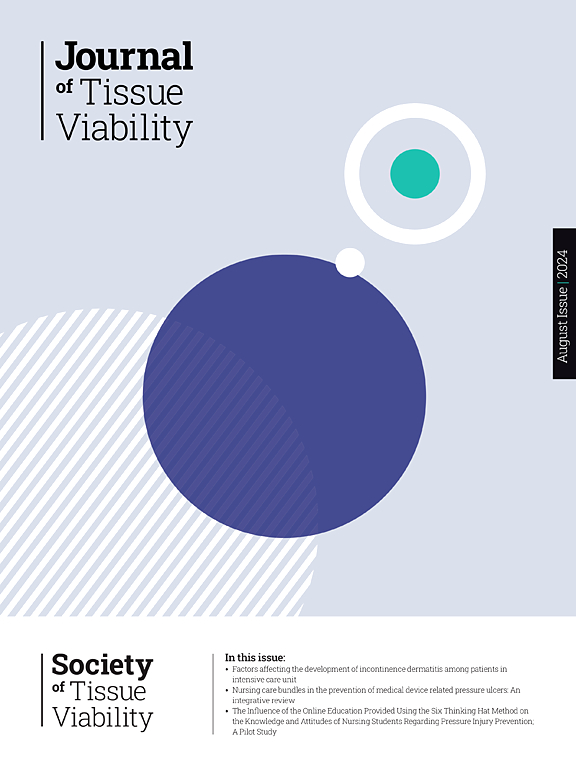外科重建(SR)治疗严重压疮(SPU)在英国:混合方法分析调查的医疗保健专业人员
IF 2.4
3区 医学
Q2 DERMATOLOGY
引用次数: 0
摘要
背景:我们调查了初级和二级保健卫生专业人员,以描述严重压疮(SPU)患者的护理和转诊治疗途径,包括手术重建(SR)。方法我们对从事初级保健工作的卫生保健专业人员、在任何环境中照顾严重脓毒症患者的护士和外科医生进行了三次在线调查,包括封闭式和开放式问题(免费文本评论框)(分别为11、30和22个问题)。参与者是通过专业组织、研究小组成员的联系以及社交媒体招募的。对封闭问题进行描述性统计,并运用专题分析原理对自由文本评论进行分析。结果接受调查的初级保健人员59人(76%为全科医生),护士146人,外科医生45人。大多数护士在医院(60%)或社区(55%)工作,几乎所有护士(93%)都接受过伤口护理培训。大多数外科医生是整形外科医生(79%),担任顾问(81%)。超过一半的初级保健受访者不知道SR是关闭spu的一种治疗选择,也从未将spu患者转介到二级保健以获得手术意见。近四分之三的护士(72%)考虑为SPU提供SR,超过一半(54%)认为应该更广泛地提供关闭SPU的SR。外科医生报告说,大多数转诊的SPU患者没有进行SR;但三分之二(68%)的人认为应该更广泛地提供SR。自由文本分析确定了系统层面(如缺乏护理途径、专门的多学科团队、资源)和患者层面(如患者的生活方式、行为和偏好)影响患者获得SR的因素。结论sour调查强调,护士和外科医生对哪些SPU患者适合SR有共识,但缺乏认识。缺乏既定的转诊途径和缺乏多学科团队是获得SR的障碍。本文章由计算机程序翻译,如有差异,请以英文原文为准。
Surgical reconstruction (SR) to treat severe pressure ulcers (SPU) in the UK: a mixed-methods analysis of surveys of healthcare professionals
Background
We surveyed primary and secondary care health professionals to describe the care and referral pathways for treatment, including surgical reconstruction (SR), for patients with a severe pressure ulcer (SPU).
Methods
We administered three online surveys comprising closed and open-ended questions (free text comment boxes) to healthcare professionals working in primary care, nurses who look after patients with severe PUs in any setting and surgeons (11, 30 and 22 questions, respectively). Participants were recruited through professional organisations, contacts of study team members and through social media. We calculated descriptive statistics for the closed questions and used principles of thematic analysis to analyse the free text comments.
Results
There were 59 primary care (76 % GPs), 146 nurse and 45 surgeon respondents. Most nurses worked in hospitals (60 %) or the community (55 %) and almost all (93 %) were trained in wound care. Most surgeons were plastic surgeons (79 %) in consultant roles (81 %). Over half of primary care respondents did not know SR is a treatment option to close SPUs and had never referred patients with SPUs to secondary care for a surgical opinion. Nearly three quarters of nurses (72 %) considered SR for a SPU and over half (54 %) believed that SR to close a SPU should be more widely available. Surgeons reported that SR was not performed for most referred SPU patients; but two thirds (68 %) believed that SR should be more widely available. There was good agreement about which patients are suitable for SR. The free-text analysis identified both system-level (e.g. lack of care pathways, dedicated multidisciplinary teams, resources) and patient-level (e.g. patient lifestyle, behaviour and preferences) factors influencing patients’ access to SR.
Conclusions
Our surveys highlighted that nurses and surgeons agree about which SPU patients are suitable for SR but lack of awareness, the absence of an established referral pathway and lack of multidisciplinary teams are barriers to access to SR.
求助全文
通过发布文献求助,成功后即可免费获取论文全文。
去求助
来源期刊

Journal of tissue viability
DERMATOLOGY-NURSING
CiteScore
3.80
自引率
16.00%
发文量
110
审稿时长
>12 weeks
期刊介绍:
The Journal of Tissue Viability is the official publication of the Tissue Viability Society and is a quarterly journal concerned with all aspects of the occurrence and treatment of wounds, ulcers and pressure sores including patient care, pain, nutrition, wound healing, research, prevention, mobility, social problems and management.
The Journal particularly encourages papers covering skin and skin wounds but will consider articles that discuss injury in any tissue. Articles that stress the multi-professional nature of tissue viability are especially welcome. We seek to encourage new authors as well as well-established contributors to the field - one aim of the journal is to enable all participants in tissue viability to share information with colleagues.
 求助内容:
求助内容: 应助结果提醒方式:
应助结果提醒方式:


